Fear of disease and dying can result in tremendous anxiety and hypervigilance to potential signs of disease. Sensations most people would not notice or certainly not worry about can result in spiraling anxiety. Such anxiety about health is often precipitated by a severe illness or a sudden death in the family, which makes people acutely aware of their mortality. In a radical attempt to avoid death, or at least to put it off until later, people sometimes work very hard to notice every sensation that might indicate an illness and then try to “fix” the illness. This anxiety impairs people’s lives, because it is difficult to find pleasure and be productive when focused on not dying.
Ruth is an example of a person who struggled with such a fear. She lived a quiet life. She was married at 20 years old, and two years later had a son. Her next pregnancy ended in a miscarriage at the end of the first trimester. Ruth’s doctor reassured her that such miscarriages were common, but Ruth’s anxiety escalated when she became pregnant again. This pregnancy also ended in a miscarriage, as did the next two. With every new pregnancy the anxiety increased, as Ruth learned to expect and fear the miscarriages. After the fourth miscarriage, Ruth was diagnosed with breast cancer. It was caught early and her surgeon was confident that the tumor was contained and no further treatment was needed after the tumor was removed. Shortly afterward, when Ruth was 30 years old, her husband was diagnosed with a brain tumor that proved to be fatal.
With every new medical problem and particularly after her husband’s death, Ruth became increasingly aware of uncomfortable physical sensations. She particularly noticed aches and pains in her abdomen and chest. She noticed changes in her heart rate. She worried that these sensations were early warning signs of cancer or heart disease, so she spent hours on the internet learning about anatomy and symptoms of various diseases. She saw her doctor at least once a month, raising new concerns, and re-raising old concerns. She had CAT scans, MRIs, EKGs, and multiple blood tests. She felt great relief when test results determined that she was not suffering from heart disease or growing cancerous tumors.
Ruth was quite frightened of dying and leaving her son as an orphan. He was her whole life. Ruth worked, but only to earn enough money to take care of herself and her son. She went to church, but did not socialize. She lost contact with her friends who gave up trying to engage her. She was afraid to go out and risk anything happening to her.
As Ruth withdrew socially, she had more time available to focus on her body. She noticed sensations in her body that she had never noticed before. When she described them to her doctor, he did not seem concerned but he also did not seem to know what to make of all of the sensations she reported. Ruth was convinced they were symptoms of something.
When she turned 40, Ruth’s doctor told her that he thought she was struggling with hypochondriasis. He explained that hypochondriasis meant she was excessively worried about having serious illnesses that she did not have. Ruth responded politely but remained relatively certain that she was ill and it simply was not being diagnosed.
Despite this conviction, Ruth decided to read about hypochondriasis. The more she learned, the more she realized that she fit the diagnosis. She recognized that she fit into a cycle of worrying about dying, searching for signs of disease, interpreting everything she experienced as a possible symptom, reading about the symptoms, seeing doctors and seeking relief through medical tests.
Ruth is an example of a person who struggled with such a fear. She lived a quiet life. She was married at 20 years old, and two years later had a son. Her next pregnancy ended in a miscarriage at the end of the first trimester. Ruth’s doctor reassured her that such miscarriages were common, but Ruth’s anxiety escalated when she became pregnant again. This pregnancy also ended in a miscarriage, as did the next two. With every new pregnancy the anxiety increased, as Ruth learned to expect and fear the miscarriages. After the fourth miscarriage, Ruth was diagnosed with breast cancer. It was caught early and her surgeon was confident that the tumor was contained and no further treatment was needed after the tumor was removed. Shortly afterward, when Ruth was 30 years old, her husband was diagnosed with a brain tumor that proved to be fatal.
With every new medical problem and particularly after her husband’s death, Ruth became increasingly aware of uncomfortable physical sensations. She particularly noticed aches and pains in her abdomen and chest. She noticed changes in her heart rate. She worried that these sensations were early warning signs of cancer or heart disease, so she spent hours on the internet learning about anatomy and symptoms of various diseases. She saw her doctor at least once a month, raising new concerns, and re-raising old concerns. She had CAT scans, MRIs, EKGs, and multiple blood tests. She felt great relief when test results determined that she was not suffering from heart disease or growing cancerous tumors.
Ruth was quite frightened of dying and leaving her son as an orphan. He was her whole life. Ruth worked, but only to earn enough money to take care of herself and her son. She went to church, but did not socialize. She lost contact with her friends who gave up trying to engage her. She was afraid to go out and risk anything happening to her.
As Ruth withdrew socially, she had more time available to focus on her body. She noticed sensations in her body that she had never noticed before. When she described them to her doctor, he did not seem concerned but he also did not seem to know what to make of all of the sensations she reported. Ruth was convinced they were symptoms of something.
When she turned 40, Ruth’s doctor told her that he thought she was struggling with hypochondriasis. He explained that hypochondriasis meant she was excessively worried about having serious illnesses that she did not have. Ruth responded politely but remained relatively certain that she was ill and it simply was not being diagnosed.
Despite this conviction, Ruth decided to read about hypochondriasis. The more she learned, the more she realized that she fit the diagnosis. She recognized that she fit into a cycle of worrying about dying, searching for signs of disease, interpreting everything she experienced as a possible symptom, reading about the symptoms, seeing doctors and seeking relief through medical tests.
Unfortunately, recognizing her pattern did not help Ruth change her behavior. She reminded herself that she was probably misinterpreting the sensations. But she was not certain and continued to scan her body for problems and sought relief through medical tests. She could not talk herself out of the idea that the sensations would lead to death. She could not divert her attention from the frightening sensations. And, she could not break the habit of going to her doctor for the brief relief that she experienced after tests indicated she was healthy.
As she continued to struggle, Ruth noticed a paradoxical element. On the one hand, Ruth continuously scanned her body for problems. On the other hand, she was frightened of paying attention to her body. She had difficulty focusing on her body calmly. Ruth knew from her extensive reading that avoidance is usually at the heart of anxiety problems. Could her avoidance of her body be causing the hypochondriasis? How could this be true if it was also true that she spent too much time scanning her body for problems?
The resolution to the paradox was that Ruth did not want to experience anything in her body. After years of anxiety, Ruth did not want to feel sensations. Being numb was the ideal state for her. She did not purposely choose to scan her body for sensations, she was pulled to do so and could not pull away from those sensations. When she did experience sensations, Ruth went to great lengths to make them go away. This realization led to a more simple understanding of the cycle:
As she continued to struggle, Ruth noticed a paradoxical element. On the one hand, Ruth continuously scanned her body for problems. On the other hand, she was frightened of paying attention to her body. She had difficulty focusing on her body calmly. Ruth knew from her extensive reading that avoidance is usually at the heart of anxiety problems. Could her avoidance of her body be causing the hypochondriasis? How could this be true if it was also true that she spent too much time scanning her body for problems?
The resolution to the paradox was that Ruth did not want to experience anything in her body. After years of anxiety, Ruth did not want to feel sensations. Being numb was the ideal state for her. She did not purposely choose to scan her body for sensations, she was pulled to do so and could not pull away from those sensations. When she did experience sensations, Ruth went to great lengths to make them go away. This realization led to a more simple understanding of the cycle:
The solution to this problem was to learn to accept what the body does. Ruth developed the following steps to solve this problem:
1. She gave herself permission to feel bodily sensations while being realistic. She said to herself, “I am going to feel things. Accept the sensations – do not try to avoid them or make them disappear.”
2. She acknowledged her anxious thoughts about the sensations (such as thoughts about cancer) and then let these thoughts go. She reminded herself that, “They are just thoughts. The thoughts distract me from the sensations. Focus on the sensations and let the thoughts go.”
3. She reminded herself not to be surprised when the anxious thoughts recurred, especially thoughts that try to explain the sensations. So, she would repeatedly let go of the anxious thoughts.
4. She stopped researching and investigating diseases.
5. She took the approach of: “Let’s just see what happens.” She did this in a non-anxious way, in an accepting/watchful/curious way.
6. She reminded herself: “I am feeling sensations – not symptoms.”
Ruth practiced these steps daily. She spent fifteen minutes every day paying attention to her body – either an uncomfortable sensation or her entire body. While doing this she went through the six steps and learned to feel comfortable with her body. After a couple of weeks, she felt dramatically better. Ruth then stopped practicing the steps because she still preferred not to notice her body. Unfortunately, the anxiety quickly returned and she needed to practice again. In the end, she learned that she needed to be willing to experience her body every day.
1. She gave herself permission to feel bodily sensations while being realistic. She said to herself, “I am going to feel things. Accept the sensations – do not try to avoid them or make them disappear.”
2. She acknowledged her anxious thoughts about the sensations (such as thoughts about cancer) and then let these thoughts go. She reminded herself that, “They are just thoughts. The thoughts distract me from the sensations. Focus on the sensations and let the thoughts go.”
3. She reminded herself not to be surprised when the anxious thoughts recurred, especially thoughts that try to explain the sensations. So, she would repeatedly let go of the anxious thoughts.
4. She stopped researching and investigating diseases.
5. She took the approach of: “Let’s just see what happens.” She did this in a non-anxious way, in an accepting/watchful/curious way.
6. She reminded herself: “I am feeling sensations – not symptoms.”
Ruth practiced these steps daily. She spent fifteen minutes every day paying attention to her body – either an uncomfortable sensation or her entire body. While doing this she went through the six steps and learned to feel comfortable with her body. After a couple of weeks, she felt dramatically better. Ruth then stopped practicing the steps because she still preferred not to notice her body. Unfortunately, the anxiety quickly returned and she needed to practice again. In the end, she learned that she needed to be willing to experience her body every day.
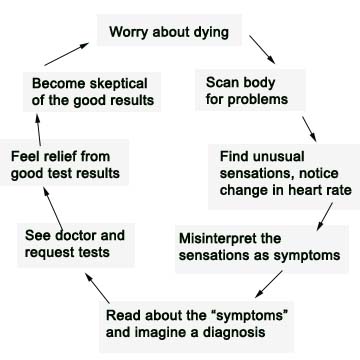
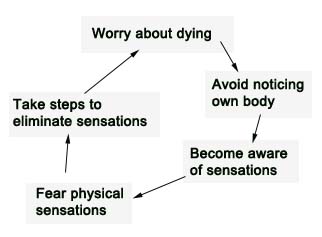
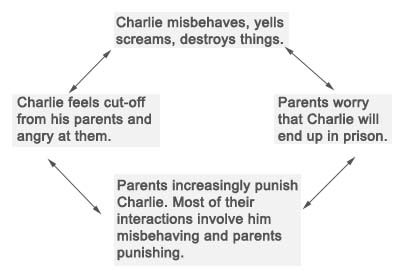
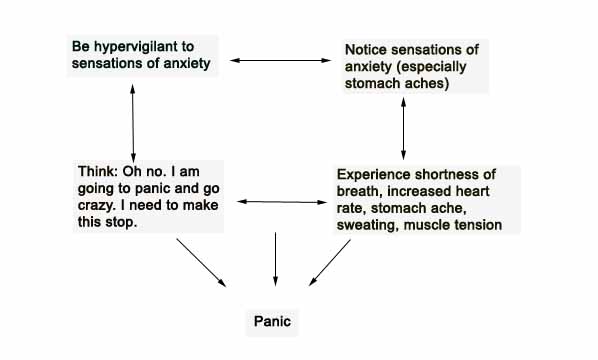
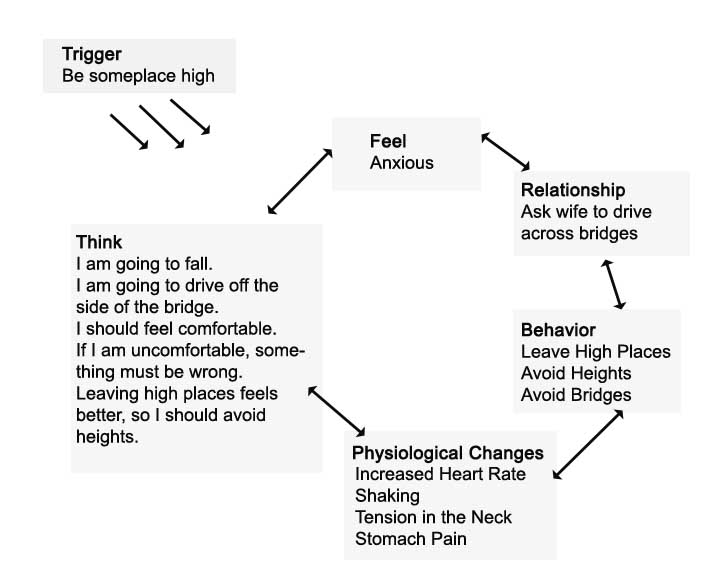
 RSS Feed
RSS Feed